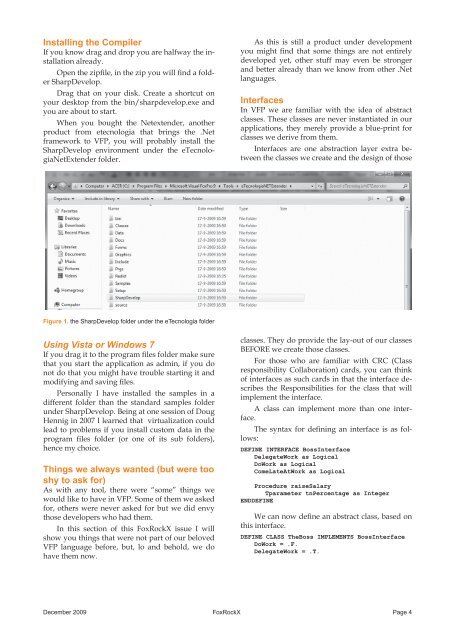Create successful ePaper yourself
Turn your PDF publications into a flip-book with our unique Google optimized e-Paper software.
Installing the Compiler<br />
If you know drag and drop you are halfway the installation<br />
already.<br />
Open the zipfile, in the zip you will find a folder<br />
SharpDevelop.<br />
Drag that on your disk. Create a shortcut on<br />
your desktop from the bin/sharpdevelop.exe and<br />
you are about to start.<br />
When you bought the Netextender, another<br />
product from etecnologia that brings the .Net<br />
framework to VFP, you will probably install the<br />
SharpDevelop environment under the eTecnologiaNetExtender<br />
folder.<br />
Figure 1. the SharpDevelop folder under the eTecnologia folder<br />
Using Vista or Windows 7<br />
If you drag it to the program files folder make sure<br />
that you start the application as admin, if you do<br />
not do that you might have trouble starting it and<br />
modifying and saving files.<br />
Personally I have installed the samples in a<br />
different folder than the standard samples folder<br />
under SharpDevelop. Being at one session of Doug<br />
Hennig in 2007 I learned that virtualization could<br />
lead to problems if you install custom data in the<br />
program files folder (or one of its sub folders),<br />
hence my choice.<br />
Things we always wanted (but were too<br />
shy to ask for)<br />
As with any tool, there were “some” things we<br />
would like to have in VFP. Some of them we asked<br />
for, others were never asked for but we did envy<br />
those developers who had them.<br />
In this section of this FoxRockX issue I will<br />
show you things that were not part of our beloved<br />
VFP language before, but, lo and behold, we do<br />
have them now.<br />
As this is still a product under development<br />
you might find that some things are not entirely<br />
developed yet, other stuff may even be stronger<br />
and better already than we know from other .Net<br />
languages.<br />
Interfaces<br />
In VFP we are familiar with the idea of abstract<br />
classes. These classes are never instantiated in our<br />
applications, they merely provide a blue-print for<br />
classes we derive from them.<br />
Interfaces are one abstraction layer extra between<br />
the classes we create and the design of those<br />
classes. They do provide the lay-out of our classes<br />
BEFORE we create those classes.<br />
For those who are familiar with CRC (Class<br />
responsibility Collaboration) cards, you can think<br />
of interfaces as such cards in that the interface describes<br />
the Responsibilities for the class that will<br />
implement the interface.<br />
A class can implement more than one interface.<br />
The syntax for defining an interface is as follows:<br />
DEFINE INTERFACE BossInterface<br />
DelegateWork as Logical<br />
DoWork as Logical<br />
ComeLateAtWork as Logical<br />
Procedure raiseSalary<br />
Tparameter tnPercentage as Integer<br />
ENDDEFINE<br />
We can now define an abstract class, based on<br />
this interface.<br />
DEFINE CLASS TheBoss IMPLEMENTS BossInterface<br />
DoWork = .F.<br />
DelegateWork = .T.<br />
December 2009 FoxRockX Page 4
















